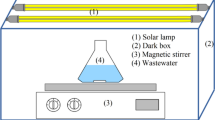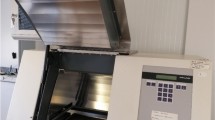Abstract
Solar photo-Fenton represents an innovative and low-cost option for the treatment of recalcitrant industrial wastewater, such as the textile wastewater. Textile wastewater usually shows high acute toxic and variability and may be composed of many different chemical compounds. This study aimed at optimizing and validating solar photo-Fenton treatment of textile wastewater in a semi-pilot compound parabolic collector (CPC) for toxicity removal and wastewater reclamation. In addition, treated wastewater reuse feasibility was investigated through pilot tests. Experimental design performed in this study indicated optimum condition for solar photo-Fenton reaction (20 mg L−1 of Fe2+ and 500 mg L−1 of H2O2; pH 2.8), which achieved 96 % removal of dissolved organic carbon (DOC) and 99 % absorbance removal. A toxicity peak was detected during treatment, suggesting that highly toxic transformation products were formed during reaction. Toxic intermediates were properly removed during solar photo-Fenton (SPF) treatment along with the generation of oxalic acid as an ultimate product of degradation and COS increase. Different samples of real textile wastewater were treated in order to validate optimized treatment condition with regard to wastewater variability. Results showed median organic carbon removal near 90 %. Finally, reuse of treated textile wastewater in both dyeing and washing stages of production was successful. These results confirm that solar photo-Fenton, as a single treatment, enables wastewater reclamation in the textile industry.

Solar photo-Fenton as a revolutionary treatment technology for “closing-the-loop” in the textile industry









Similar content being viewed by others
References
Al Momani F, Sans C, Esplugas S (2004) A comparative study of the advanced oxidation of 2,4-dichlorophenol. J Hazard Mater 107:123–129
Amat AM, Arques A, Galindo F, Miranda MA, Santos-Juanes L, Vercher RF, Vicente R (2007) Acridine yellow as solar photocatalyst for enhancing biodegradability and eliminating ferulic acid as model pollutant. Appl Catal B Environ 73:220–226
APHA, AWWA, WEF (2005) Standard methods for the examination of water and wastewater. APHA, Washington
Blanco J, Torrades F, Morón M, Brouta-Agnésa M, García-Montaño J (2014) Photo-Fenton and sequencing batch reactor coupled to photo-Fenton processes for textile wastewater reclamation: feasibility of reuse in dyeing processes. Chem Eng J 240:469–475
Catalkaya EC, Kargi F (2008) Advanced oxidation treatment of pulp mill effluent for TOC and toxicity removals. J Environ Manag 87:396–404
Contreras S, Rodríguez M, Momani FA, Sans C, Esplugas S (2003) Contribution of the ozonation pre-treatment to the biodegradation of aqueous solutions of 2,4-dichlorophenol. Water Res 37:3164–3171
Dean RB, Dixon WJ (1951) Simplified statistics for small numbers of observations. Anal Chem 23:636–638
dos Santos AB, Cervantes FJ, van Lier JB (2007) Review paper on current technologies for decolourisation of textile wastewaters: perspectives for anaerobic biotechnology. Bioresour Technol 98:2369–2385
Doumic LI, Soares PA, Ayude MA, Cassanello M, Boaventura RAR, Vilar VJP (2015) Enhancement of a solar photo-Fenton reaction by using ferrioxalate complexes for the treatment of a synthetic cotton-textile dyeing wastewater. Chem Eng J 277:86–96
Foo KY, Hameed BH (2010) Decontamination of textile wastewater via TiO2/activated carbon composite materials. Adv Colloid Interf Sci 159:130–143
FOTOTEX (2005) Water purification tertiary treatment using photo-oxidation at semi-industrial scale.
ISO (2007) Water quality—determination of the inhibitory effect of water samples on the light emission of Vibrio fischeri (luminescent bacteria test)—part 3: method using freeze-dried bacteria
Johnson BT (2005) Microtox® acute toxicity test. In: Blaise C, Férard J-F (Eds) Small-scale freshwater toxicity investigations: toxicity test methods. Springer, 69–105
Kalsoom U, Ashraf SS, Meetani MA, Rauf MA, Bhatti HN (2012) Degradation and kinetics of H2O2 assisted photochemical oxidation of Remazol turquoise blue. Chem Eng J 200–202:373–379
Karci A (2014) Degradation of chlorophenols and alkylphenol ethoxylates, two representative textile chemicals, in water by advanced oxidation processes: the state of the art on transformation products and toxicity. Chemosphere 99:1–18
Khandegar V, Saroha AK (2013) Electrocoagulation for the treatment of textile industry effluent—a review. J Environ Manag 128:949–963
Lapertot M, Ebrahimi S, Oller I, Maldonado MI, Gernjak W, Malato S, Pulgarín C (2008) Evaluating Microtox© as a tool for biodegradability assessment of partially treated solutions of pesticides using Fe3+ and TiO2 solar photo-assisted processes. Ecotoxicol Environ Saf 69:546–555
Machulek A, Moraes JEF, Vautier-Giongo C, Silverio CA, Friedrich LC, Nascimento CAO, Gonzalez MC, Quina FH (2007) Abatement of the inhibitory effect of chloride anions on the photo-Fenton process. Environ Sci Technol 41:8459–8463
Malato S, Fernández-Ibáñez P, Maldonado MI, Blanco J, Gernjak W (2009) Decontamination and disinfection of water by solar photocatalysis: recent overview and trends. Catal Today 147:1–59
Manenti DR, Módenes AN, Soares PA, Espinoza-Quiñones FR, Boaventura RAR, Bergamasco R, Vilar VJP (2014) Assessment of a multistage system based on electrocoagulation, solar photo-Fenton and biological oxidation processes for real textile wastewater treatment. Chem Eng J 252:120–130
Manenti DR, Soares PA, Silva TFCV, Módenes AN, Espinoza-Quiñones FR, Bergamasco RB, Boaventura RAR, Vilar VJP (2015) Performance evaluation of different solar advanced oxidation processes applied to the treatment of a real textile dyeing wastewater. Environ Sci Pollut Res 22(2):833–845
Marcelino RBP, Queiroz MTA, Amorim CC, Leão MMD, Brites-Nóbrega FF (2015) Solar energy for wastewater treatment: review of international technologies and their applicability in Brazil. Environ Sci Pollut Res 22:762–773
Módenes AN, Espinoza-Quiñones FR, Manenti DR, Borba FH, Palácio SM, Colombo A (2012) Performance evaluation of a photo-Fenton process applied to pollutant removal from textile effluents in a batch system. J Environ Manag 104:1–8
Monteagudo JM, Durán A, Corral JM, Carnicer A, Frades JM, Alonso MA (2012) Ferrioxalate-induced solar photo-Fenton system for the treatment of winery wastewaters. Chem Eng J 181–182:281–288
Moreira FC, Garcia-Segura S, Vilar VJP, Boaventura RAR, Brillas E (2013) Decolorization and mineralization of Sunset Yellow FCF azo dye by anodic oxidation, electro-Fenton, UVA photoelectro-Fenton and solar photoelectro-Fenton processes. Appl Catal B Environ 142–143:877–890
Nogueira RFP, Oliveira MC, Paterlini WC (2005) Simple and fast spectrophotometric determination of H2O2 in photo-Fenton reactions using metavanadate. Talanta 66:86–91
Pinheiro HM, Touraud E, Thomas O (2004) Aromatic amines from azo dye reduction: status review with emphasis on direct UV spectrophotometric detection in textile industry wastewaters. Dyes Pigments 61:121–139
Poole AJ (2004) Treatment of biorefractory organic compounds in wool scour effluent by hydroxyl radical oxidation. Water Res 38:3458–3464
Punzi M, Nilsson F, Anbalagan A, Svensson B-M, Jonsson K, Mattiasson B, Jonstrup M (2015) Combined anaerobic-ozonation process for treatment of textile wastewater: removal of acute toxicity and mutagenicity. J Hazard Mater 292:52–60
PURIFAST (2012) PURIFAST: advanced purification of industrial and mixed wastewater by combined membrane filtration and sonochemical technologies
Ribeiro MCM, Starling MCVM, Leão MMD, de Amorim CC (2016) Textile wastewater reuse after additional treatment by Fenton’s reagent. Environ Sci Pollut Res:1–11
Rodrigues CSD, Madeira LM, Boaventura RAR (2013) Optimization and economic analysis of textile wastewater treatment by photo-Fenton process under artificial and simulated solar radiation. Ind Eng Chem Res 52:13313–13324
Saggioro EM, Oliveira AS, Buss DF, Magalhães DP, Pavesi T, Jimenéz M, Maldonado MI, Ferreira LFV, Moreira JC (2015) Photo-decolorization and ecotoxicological effects of solar compound parabolic collector pilot plant and artificial light photocatalysis of indigo carmine dye. Dyes Pigments 113:571–580
Schenone AV, Conte LO, Botta MA, Alfano OM (2015) Modeling and optimization of photo-Fenton degradation of 2,4-D using ferrioxalate complex and response surface methodology (RSM). J Environ Manag 155:177–183
Sirés I, Garrido JA, Rodríguez RM, Pll C, Centellas F, Arias C, Brillas E (2006) Electrochemical degradation of paracetamol from water by catalytic action of Fe2 + , Cu2 + , and UVA light on electrogenerated hydrogen peroxide. J Electrochem Soc 153:D1–D9
Soares P, Silva TCV, Manenti D, Souza SAGU, Boaventura RR, Vilar VP (2014) Insights into real cotton-textile dyeing wastewater treatment using solar advanced oxidation processes. Environ Sci Pollut Res 21:932–945
Soares PA, Batalha M, Souza SMAGU, Boaventura RAR, Vilar VJP (2015) Enhancement of a solar photo-Fenton reaction with ferric-organic ligands for the treatment of acrylic-textile dyeing wastewater. J Environ Manag 152:120–131
Starling MCVM, Castro LAS, Marcelino RBP, Leão MMD, Amorim CC (2016): Optimized treatment conditions for textile wastewater reuse using photocatalytic processes under UV and visible light sources. Environ Sci Pollut Res, 1–11
STATISTICA (2010) STATSOFT. In: 10 (Hrsg.), Tulsa, USA
Stumm W, Morgan JJ (1995) Aquatic chemistry, 3rd edn. Wiley, New York
Tarr MA (2003) Chemical degradation methods for wastes and pollutants—environmental and industrial applications, New York, NY
Trovó AG, Pupo Nogueira RF, Aguera A, Fernandez-Alba AR, Malato S (2012) Paracetamol degradation intermediates and toxicity during photo-Fenton treatment using different iron species. Water Res 46:5374–5380
Vajnhandl S, Valh JV (2014) The status of water reuse in European textile sector. J Environ Manag 141:29–35
Vedrenne M, Vasquez-Medrano R, Prato-Garcia D, Frontana-Uribe BA, Hernandez-Esparza M, de Andrés JM (2012) A ferrous oxalate mediated photo-Fenton system: toward an increased biodegradability of indigo dyed wastewaters. J Hazard Mater 243:292–301
Verma AK, Dash RR, Bhunia P (2015) A review on chemical coagulation/flocculation technologies for removal of colour from textile wastewaters. J Environ Manag 93:154–168
Vilar VJP, Pinho LX, Pintor AMA, Boaventura RAR (2011) Treatment of textile wastewaters by solar-driven advanced oxidation processes. Sol Energy 85:1927–1934
Wang X, Zeng G, Zhu J (2008) Treatment of jean-wash wastewater by combined coagulation, hydrolysis/acidification and Fenton oxidation. J Hazard Mater 153:810–816
Zapata A, Oller I, Rizzo L, Hilgert S, Maldonado MI, Sánchez-Pérez JA, Malato S (2010) Evaluation of operating parameters involved in solar photo-Fenton treatment of wastewater: interdependence of initial pollutant concentration, temperature and iron concentration. Appl Catal B Environ 97:292–298
Acknowledgments
The authors would like to thank FAPEMIG, CAPES, CNPQ, and BNDES for their financial support and the textile industry for their trustworthy collaboration.
Author information
Authors and Affiliations
Corresponding author
Additional information
Responsible editor: Vítor Pais Vilar
Electronic supplementary material
ESM 1
(DOC 2209 kb)
Rights and permissions
About this article
Cite this article
Starling, M.C.V.M., dos Santos, P.H.R., de Souza, F.A.R. et al. Application of solar photo-Fenton toward toxicity removal and textile wastewater reuse. Environ Sci Pollut Res 24, 12515–12528 (2017). https://doi.org/10.1007/s11356-016-7395-5
Received:
Accepted:
Published:
Issue Date:
DOI: https://doi.org/10.1007/s11356-016-7395-5




